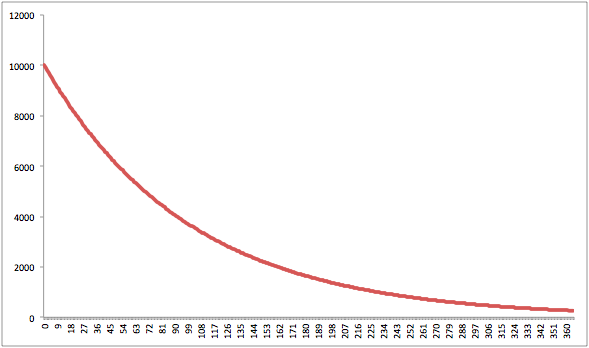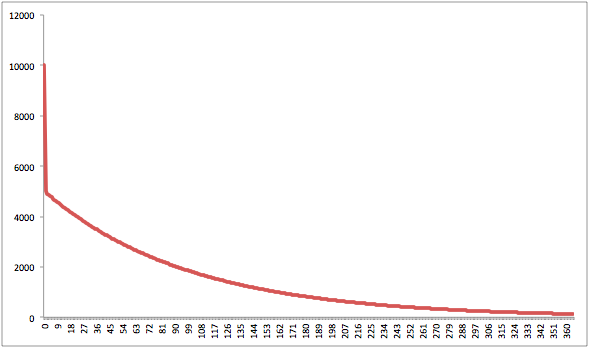Visualizing retention in Freemium projects
The original version of the material can be found on Mobile Dev Memo, a website dedicated to the mobile industry, hosted by Eric Seferth himself, author of the book Freemium Economics.
App2Top.ru together with Apptractor.ru begins publishing the “Freemium Code”, a series of articles dedicated to this business model. The selection was compiled by Eric Benjamin Seufert, head of marketing at Wooga.
Actually, the selection begins with his article.
Visualizing retention in Freemium projects
The retention curve for a freemium product is usually considered as a negative exponential function, as shown in the graph below:
But there is one “but”.
The retention curve, in theory, could take this form if, in the early stages of product use, retention would depend solely on the quality of the product. In fact, things are a little different. In the beginning, the level of returns – especially on the first day – is primarily due to marketing.
- The presence of different traffic channels in the early stages can have a negative impact. When an application is promoted in inappropriate channels (the wrong audience) or not properly (the description incorrectly presents the product to the audience) or even resorts to motivated installations, retention on the first day may be much lower than it should be.
- Inefficiently used demographic targeting can reduce retention on the first day. This is due to attracting unsuitable users. As a rule, large and large-scale marketing campaigns can lead to strong drops in returns on the first day.
In other words, any aggressively promoted freemium product (all freemium applications should strive for a position in which active ongoing marketing will be profitable) will show a retention level on the first day lower than predicted by the exponential function.
Because of this, when retention rates for freemium applications are calculated based on cohort analysis (as shown here), the value of the first day will show a large deviation from the original cohort distribution in the product.
Given the outflow of users, the retention metric for the second day and further days will look like a function of the negative exponent:
A significant decrease in the number of users at the very beginning of the retention curve has a big impact on total, aggregate income.
Why?
Everything is simple. Users can only give money to the product while they log in to it (sic!). There are fewer of them every day. And if so, it is logical to assume that the greatest opportunities for monetization exist at an early stage of launch, when most users are still active.
But incorrect marketing can easily lead to the fact that even the first paying users of the project may not be.
There is also another problem here.
Monetization of the user at an early stage of life in the product goes against the purpose of the freemium model, which assumes a higher level of engagement (and monetization) than with paid access (in other words, why was free-to-play invented, if not to “milk” the user as long as possible).
Users, as a rule, do not become active adherents of the product on the first day of their work with it, they need time to understand its compliance with their needs, familiarize themselves with it and allocate time for it in their lives.
From the editors: by the way, there is a controversial point here. If the user, who is already suffocating from a wide choice, is not interested in the project after the first launch, then how can we guarantee that he will return to it?
Products that aggressively try to monetize users on the first day run the risk of alienating users who could become the most loyal (and, as a result, spending the most money during their lifetime in the app). It is necessary to find a balance: start monetizing users as early as possible, while there are a lot of them, but those products that are trying to extract money from their users before they understand the benefits of the application may face premature outflow.
From the editors: another controversial point. If the developer knows that there is a high probability of non-return, it may be more profitable for him (not always, but still) to try to make money on the user right away. Plus, paywall in free-to-play can serve as a good filter in pay-to-win projects.
While the effect of shifting the monetization schedule inside the product forward is difficult to track without careful testing, the upward shift of the retention curve poses no danger to the accelerated outflow of users or their dissatisfaction when retention increases, monetization also increases.
Retention is much more important to optimize in product iterations and updates than monetization. On the one hand, the effect of changing monetization mechanisms is very difficult to isolate and very often it lasts for a long period of time, which can make interpretation difficult.
On the other hand, changes in the product aimed at increasing returns, by definition, are aimed at increasing the number of users existing in the application in the future. All other things being equal, a user base that is more preserved through product improvements focused on retention has a higher potential for monetization than one that is experiencing an unrestrained outflow. Saved users can always be subjected to experiments with monetization later.
Recognizing the reality of the monetization curve, there is no practical difference in terms of revenue – will we improve retention or monetization.
Consider users on the first day with a 50% refund rate, an ARPDAU of $0.05 and a retention profile that we described above. An initial cohort of 10,000 users will bring a total revenue of $24,731, as shown below (you can find the table for this graph here):
An increase in ARPDAU by 20% to 6 cents or an increase in the level of refunds on the first day to 60% will result in approximately the same increase in total income by 20% (an increase in refunds will have a slightly smaller effect due to the fact that ARPDAU is applied from the first day).
But a 20% increase in ARPDAU will be much harder to achieve – and then probably more easily lost – than a 20% increase in retention. The model above assumes that refunds remain constant despite the changes in ARPDAU, which is not realistic: most likely, the retention will fall as the application asks users for money more strongly.
The same cannot be said about improved retention, which is often an improvement in the user interface, graphics, loading time and other fundamental changes that increase the joy of the product. These are truly objective improvements, changes that make the product more attractive, effective or spectacular.
The advantage of working with the retention of users in the project is that minimal changes concerning it do not cause the price reaction that can be met if you “turn the nuts” in monetization.
Improving returns makes it possible to only and explicitly improve the product without worrying about hidden negative consequences that will manifest only later towards the end of the user’s life.
The article was published as part of a joint series of materials “The Freemium Code” of mobile development sites App2Top.ru and Apptractor.ru .
Original translation: http://apptractor.ru/marketing-monetization/engagement/retention-freemium.html
Original material: http://mobiledevmemo.com/visualizing-importance-retention-freemium/



